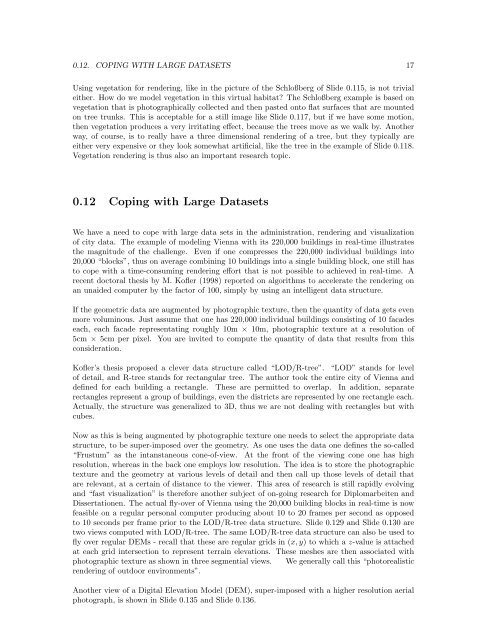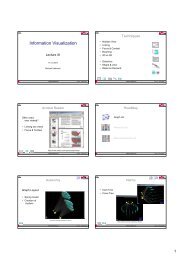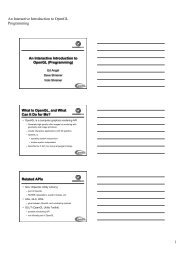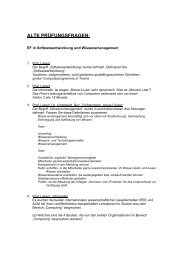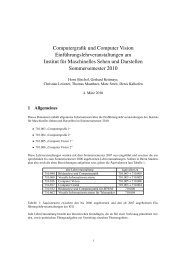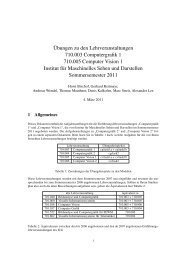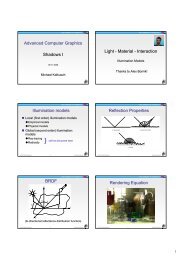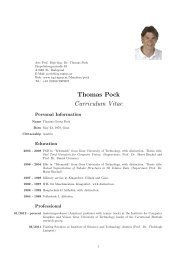Lehrveranstaltungsinhalt aus - Institute for Computer Graphics and ...
Lehrveranstaltungsinhalt aus - Institute for Computer Graphics and ...
Lehrveranstaltungsinhalt aus - Institute for Computer Graphics and ...
Create successful ePaper yourself
Turn your PDF publications into a flip-book with our unique Google optimized e-Paper software.
0.12. COPING WITH LARGE DATASETS 17<br />
Using vegetation <strong>for</strong> rendering, like in the picture of the Schloßberg of Slide 0.115, is not trivial<br />
either. How do we model vegetation in this virtual habitat? The Schloßberg example is based on<br />
vegetation that is photographically collected <strong>and</strong> then pasted onto flat surfaces that are mounted<br />
on tree trunks. This is acceptable <strong>for</strong> a still image like Slide 0.117, but if we have some motion,<br />
then vegetation produces a very irritating effect, bec<strong>aus</strong>e the trees move as we walk by. Another<br />
way, of course, is to really have a three dimensional rendering of a tree, but they typically are<br />
either very expensive or they look somewhat artificial, like the tree in the example of Slide 0.118.<br />
Vegetation rendering is thus also an important research topic.<br />
0.12 Coping with Large Datasets<br />
We have a need to cope with large data sets in the administration, rendering <strong>and</strong> visualization<br />
of city data. The example of modeling Vienna with its 220,000 buildings in real-time illustrates<br />
the magnitude of the challenge. Even if one compresses the 220,000 individual buildings into<br />
20,000 “blocks”, thus on average combining 10 buildings into a single building block, one still has<br />
to cope with a time-consuming rendering ef<strong>for</strong>t that is not possible to achieved in real-time. A<br />
recent doctoral thesis by M. Kofler (1998) reported on algorithms to accelerate the rendering on<br />
an unaided computer by the factor of 100, simply by using an intelligent data structure.<br />
If the geometric data are augmented by photographic texture, then the quantity of data gets even<br />
more voluminous. Just assume that one has 220,000 individual buildings consisting of 10 facades<br />
each, each facade representating roughly 10m × 10m, photographic texture at a resolution of<br />
5cm × 5cm per pixel. You are invited to compute the quantity of data that results from this<br />
consideration.<br />
Kofler’s thesis proposed a clever data structure called “LOD/R-tree”. “LOD” st<strong>and</strong>s <strong>for</strong> level<br />
of detail, <strong>and</strong> R-tree st<strong>and</strong>s <strong>for</strong> rectangular tree. The author took the entire city of Vienna <strong>and</strong><br />
defined <strong>for</strong> each building a rectangle. These are permitted to overlap. In addition, separate<br />
rectangles represent a group of buildings, even the districts are represented by one rectangle each.<br />
Actually, the structure was generalized to 3D, thus we are not dealing with rectangles but with<br />
cubes.<br />
Now as this is being augmented by photographic texture one needs to select the appropriate data<br />
structure, to be super-imposed over the geometry. As one uses the data one defines the so-called<br />
“Frustum” as the intanstaneous cone-of-view. At the front of the viewing cone one has high<br />
resolution, whereas in the back one employs low resolution. The idea is to store the photographic<br />
texture <strong>and</strong> the geometry at various levels of detail <strong>and</strong> then call up those levels of detail that<br />
are relevant, at a certain of distance to the viewer. This area of research is still rapidly evolving<br />
<strong>and</strong> “fast visualization” is there<strong>for</strong>e another subject of on-going research <strong>for</strong> Diplomarbeiten <strong>and</strong><br />
Dissertationen. The actual fly-over of Vienna using the 20,000 building blocks in real-time is now<br />
feasible on a regular personal computer producing about 10 to 20 frames per second as opposed<br />
to 10 seconds per frame prior to the LOD/R-tree data structure. Slide 0.129 <strong>and</strong> Slide 0.130 are<br />
two views computed with LOD/R-tree. The same LOD/R-tree data structure can also be used to<br />
fly over regular DEMs - recall that these are regular grids in (x, y) to which a z-value is attached<br />
at each grid intersection to represent terrain elevations. These meshes are then associated with<br />
photographic texture as shown in three segmential views. We generally call this “photorealistic<br />
rendering of outdoor environments”.<br />
Another view of a Digital Elevation Model (DEM), super-imposed with a higher resolution aerial<br />
photograph, is shown in Slide 0.135 <strong>and</strong> Slide 0.136.


